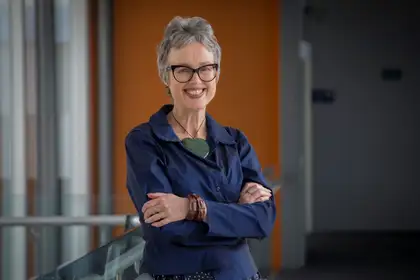
Provost Professor Giselle Byrnes.
By Professor Giselle Byrnes
No doubt about it, the Covid-19 pandemic is encouraging all of us to think around corners, to look creatively at what we can do differently in the context of a crisis. Whether this means changing our practices in the workplace or modifying our every day social encounters, the reality of working in the Covid-19 environment is demonstrating that we embrace change and do so quickly.
Here in New Zealand, we’re following the "no handshakes, hongi or hugs" advice and swiftly implementing practical logistics to prevent further spread of the virus. In recent days, the New Zealand Government has announced unprecedented new restrictions requiring all inbound travellers to be quarantined for 14 days upon entry into the country in an attempt to stop the spread of coronavirus. Urgent times call for urgent measures. I suggest that the higher education sector is no different to other industries in needing to remain agile, adaptable and responsive, not just in keeping students and staff safe, but rapidly adapting our business as usual to the new world of online learning and teaching.
Universities internationally, especially those who have over-extended their reliance on international full-fee paying students, are currently scrambling to convert their classes into online mode. A number of British universities have, during the past week, cancelled lectures in an effort to arrest the contagion of the virus, with bold commitments to convert teaching and assessment from traditional classrooms to online platforms within a matter of weeks. The London School of Economics, King’s College London, the University of Durham and Manchester Metropolitan University are all dispensing with face-to-face teaching in favour of digital delivery, featuring online lectures and seminars.
Responding to a crisis is one thing, but embedding online teaching practice as a normative style of teaching and learning takes time; not just to get to grips with the new platforms, technology and software (often known as learning management systems), but to support academic staff, accustomed to teaching in a style virtually unchanged for hundreds of years, to transform their own practice and teaching approaches. Far from being the "shock of the new", there has been something of a quiet revolution in many universities who are well down this path.
At my own university, more or less half of our students study via "distance". Last year alone, 18,000 of our 30,000 students chose to study off campus. While many of these students study in what is often referred to as a ‘blended’ mode – a mixture of on-campus and online teaching and learning – a large number of these students study fully online. Many of these live at a distance from one of our three campuses distributed throughout the North Island of New Zealand or work fulltime or have other life commitments that prevent them from accessing a university education in the same way that a fulltime student might. It is true that many of these students are part-time learners who, in the past, would have found it impossible to access a university education; they are part of the lifelong learning generation who are driving a fundamental shift in our knowledge economy, graduates who will be ideally suited to the volatile and highly disruptive future, preparing themselves for what is often termed the fourth industrial revolution. This all speaks to Massey’s distinctive mission and purpose. As a research-intensive university, we’ve always had a longstanding commitment to providing students with access to distance learning across New Zealand and beyond, in addition to providing a quality ‘on campus’ learning experience on a par with that provided at world-class universities.
While the term "distance" in the context of learning is one our funder insists on (and it is convenient for administrative purposes), students demand and deserve a seamless experience, regardless of the mode in which they enrol. The term "distance" is also slightly odd. As Kevin Carey forcefully argued in The End of College: Creating the Future of Learning and the University of Everywhere (2015), the term "distance education", commonly used to describe learning transmitted by mail, screen or an online platform, is a misnomer. All education, argues Carey, is distance education in that ‘an educational process or environment is designed by people other than you, in a way that is meant to instigate learning that would not have happened had you been left to your own devices’. There is always some sort of mediator, be it the teacher, the tutor or lab instructor sitting alongside you or speaking with you via an electronic medium. The point is: education is a process of engagement, dialogue and development, not simply a process of singular and individual discovery.
Setting semantics to one side, distance education, particularly education facilitated via a screen, is not a particularly new phenomena. In the early twentieth century, when the emergent film industry was popular, pundits predicted the demise of on-campus education, especially in the United States. The same doom merchants proclaimed similar messages in the 1950s with the advent of television. But the campus based university experience survived, alongside distance education. Partly this was due to the value placed on the currency and status of the graduating university qualification – an Ivy League degree commanding premium value – and acknowledgement of the intrinsic value of human contact in the experiences of teaching and learning in addition to the convenience and flexibility provided by distance education.
It would also be true to say that MOOCs (Massive Open Online Courses) have significantly lifted student expectations of their own university experience. While MOOCs may not have dislodged the credentialing power and standing of universities, they have nonetheless set a new standard of online curriculum design that many universities now believe they must emulate. It is generally agreed that while the business model underpinning MOOCs remains problematic, they are highly effective marketing platforms which continue to raise the bar in terms of democratising higher education delivery modes. Universities should not be fearful of MOOCs eating our own business, but we do need to learn from them.
So what does this sort of innovation look like? At Massey, we have moved beyond "lecture capture", which is a rather passive way of recording unedited lectures for students to view at a time suitable to them. Our own work is focused on making learning available both synchronously, in real time, as well as asynchronously, accessed anytime. This has involved thinking about timetable considerations, maintaining high quality learning outcomes while changing the nature and often the type of assessment, re-thinking the way in which material is presented and, of critical importance, ensuring that we have the appropriate support for academic teaching staff. Teaching online is not simply a case of setting up a camera in the lecture theatre and letting it run; make no mistake, teaching online is different to classroom teaching and requires a highly-developed skill set.

Massey University academics are working with teams of designers, developers and IT specialists, to accelerate the University's digital capacity and capability.
Here at Massey, our academics – many of whom are award-winning teachers – are working with teams of designers, developers and IT specialists, to accelerate our digital capacity and capability. This programme of work predates the current challenges and was part and parcel of our own natural evolution as a distance provider. This has focused on ensuring a much more co-created approach to our learning design and teaching. At Massey, the oft-held assumption that online learning was only an option for technologically minded teaching staff no longer holds true, requiring all of us to embrace online learning, customised to the needs of the discipline area.
Of course there are critics who say that online learning will never replace the "real" on-campus experience. And it has been argued that meeting with people, interacting with one’s peers, students and supervisors is the key to learning and understanding. This is all true; human-to-human interaction is a key part of the teaching and learning dynamic and online instruction does not seek to replace that in its entirety. At its very best, modern online teaching can offer highly personalised learning, offering the "just in time and just for me" access that students now crave. Learning management systems, once simply used as repositories of information, are now being fully exploited to allow students to engage as if they were in the classroom and, often, the learning experience is richer and deeper and more highly tailored than it might be in the traditional "sage on a stage" lecture theatre model.
Indeed, many universities (my own included) are eschewing the default format of the passive lecture style, towards a more interactive seminar, workshop and "lectorial" type of engagement that has more in common with the flipped classroom approach, where the focus in class time is on discussion and thinking and ‘content’ is delivered and consumed out of standard class time. On the other hand, hard evidence for the superiority of the classroom to the online experience is difficult to find, as is empirical evidence that classroom instruction benefits students (compared to alternatives) from a learning achievement perspective. More important than the medium was whether university teachers could "capture and challenge the imagination, based on the learners’ pre-existing knowledge".
When, some 18 months ago, the Times Higher Education surveyed leaders of prominent global universities, the 200 respondents – from 45 countries across six continents – were of the view that online higher education would not displace on-campus education. Although 63 per cent of these leaders expected the more established and prestigious universities to be offering full degrees online by 2030, only 24 per cent thought that online learning would be more popular than the traditional campus-based mode. Perhaps the current pandemic will shift this thinking. And there are precedents for this sort of game-changing disruption. It is well-recognised that in the early twenty-first century, the SARS outbreak effectively drove the e-commerce revolution in China. SARS was a tipping point for China’s two biggest online retail leaders, Alibaba and JD.com. At the time, e-commerce in China was relatively nascent with a reluctance to move away from traditional selling and buying practices. Prior to SARS, for those retailers who offered some online provision, employees had to manually record orders and send text messages to customers when orders had been shipped. Employees often personally delivered orders to customers. At the same time, JD.com, an emerging electronics retailer, resorted to selling electronics via internet forums and online chat groups to keep the business alive during the SARS crisis. It later become China’s largest online retailer of electronic products. We pride ourselves on our ability to drive innovation and creativity in our research. Teaching and learning online is no longer the future, it is the present.